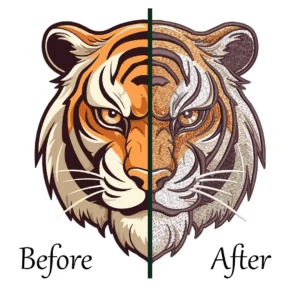


ZDigitizing is offering a wide range of digitizing solutions to meet the needs of businesses and individuals alike. With expertise in logo digitizing.
Online embroidery digitizing has emerged as a game-changer in the world of embroidery, offering a modern alternative to traditional digitizing methods. Both approaches convert artwork into digital stitch files for embroidery machines, but they differ significantly in process, accessibility, and efficiency. Providers like ZDigitizing exemplify the power of online solutions, delivering precision and convenience. This comprehensive blog compares online embroidery digitizing with traditional digitizing, exploring their strengths, limitations, and suitability for businesses, artisans, and hobbyists. A detailed FAQ section at the end addresses common questions to guide users in choosing the best method for their needs.
Embroidery digitizing transforms logos, artwork, or designs into digital files (e.g., DST, PES) that instruct embroidery machines on stitch patterns, colors, and sequences. Whether for fashion, sports, branding, or personalized gifts, digitizing ensures designs are accurately stitched onto fabrics. Traditional digitizing relies on in-house expertise and software, while online digitizing outsources the process to expert providers via digital platforms. Comparing these methods reveals which aligns best with modern demands.
Traditional digitizing involves creating stitch files in-house, typically by a trained digitizer using specialized software. Here’s how it works:
Process: A digitizer manually converts artwork into stitch files using software like Wilcom or Brother PE-Design, adjusting stitch types, density, and sequences.
Tools Required: Expensive software, high-performance computers, and sometimes graphics tablets for precision.
Expertise Needed: Requires extensive training to master software and understand fabric properties, stitch dynamics, and machine compatibility.
This method was the standard for decades, used by embroidery shops, large brands, and in-house production teams.
Online digitizing leverages remote services, allowing users to outsource the process to expert providers through user-friendly platforms. Here’s the overview:
Process: Users upload artwork to a provider’s website, specify details (e.g., fabric, file format), and receive a digitized file, often within 2-12 hours.
Tools Required: Only a device with internet access to upload files and communicate with the provider.
Expertise Needed: Minimal, as professional digitizers handle the technical aspects, making it accessible to beginners and businesses.
Providers like ZDigitizing streamline this process, delivering high-quality files with advanced technology and support.
To understand which method suits your needs, let’s compare online and traditional digitizing across critical factors.
Traditional: Requires significant technical knowledge and software proficiency, limiting access to trained professionals or those willing to invest in learning.
Online: User-friendly platforms make it accessible to anyone, from hobbyists to business owners, with no need for technical skills. Upload artwork, provide instructions, and receive files effortlessly.
Winner: Online digitizing, for its simplicity and inclusivity.
Traditional: High upfront costs for software (often $1,000-$5,000), hardware, and training. Ongoing expenses include software updates and staff salaries.
Online: Affordable, with no software or training costs. Pricing is per design or via subscriptions, with bulk discounts for large orders. ZDigitizing offers competitive rates, making it budget-friendly.
Winner: Online digitizing, for eliminating major investments.
Traditional: Time-intensive, as digitizing a single design can take hours or days, depending on complexity and the digitizer’s skill. In-house bottlenecks can delay production.
Online: Rapid delivery, often within 2-12 hours, thanks to automation, AI, and expert teams. Rush services cater to urgent needs, like event merchandise.
Winner: Online digitizing, for its unmatched speed.
Online embroidery digitizing surpasses traditional digitizing in accessibility, speed, cost-effectiveness, and scalability, making it the preferred choice for modern businesses and creators. ZDigitizing leads the way, leveraging AI, cloud platforms, and eco-friendly practices to deliver precise, professional stitch files for fashion, sports, and branding. While traditional digitizing suits niche in-house needs, online platforms offer unmatched convenience and innovation. As AR, blockchain, and IoT reshape the industry, online digitizing will continue to dominate, empowering users to create stunning embroidery with ease.
What is embroidery digitizing?
It’s the process of converting artwork into digital stitch files for embroidery machines to create designs on fabrics.
How does online digitizing differ from traditional?
Online digitizing outsources the process to experts via platforms, while traditional involves in-house software and expertise.
Is online digitizing more affordable?
Yes, it eliminates software and training costs, offering competitive pricing and bulk discounts.
Which method is faster?
Online digitizing, with turnarounds of 2-12 hours, outpaces traditional methods, which can take days.
Does traditional digitizing offer better quality?
No, online platforms use AI and expert digitizers to ensure high-quality, error-free files, often surpassing in-house results.
